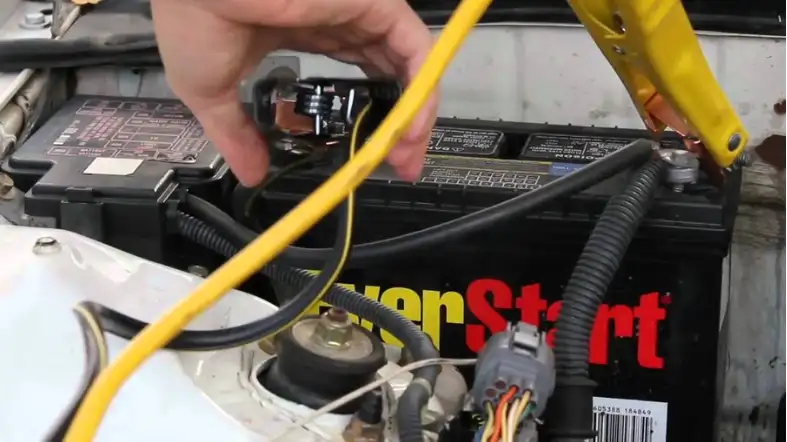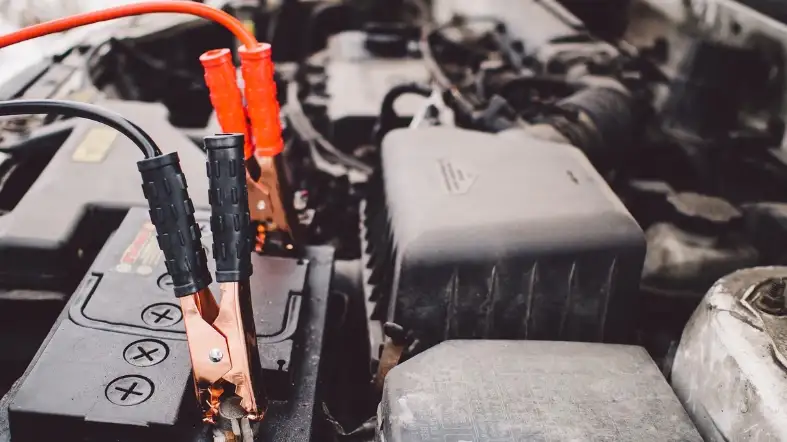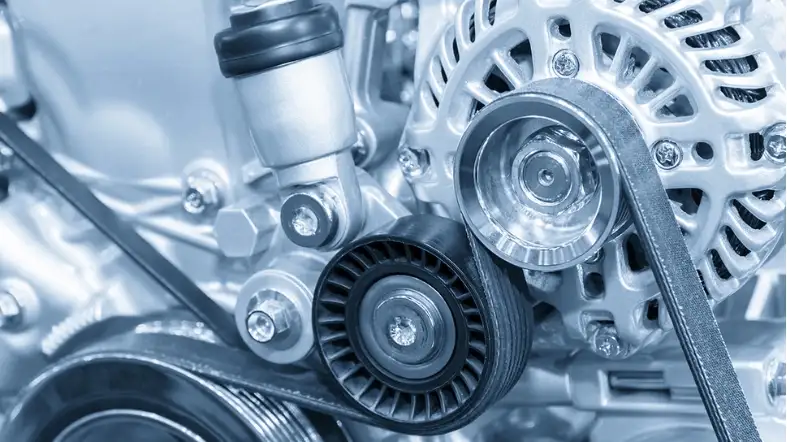A bad starter or bad battery can cause frustrating issues for any vehicle owner.
The starter is responsible for turning the engine over, and a bad starter can result in the engine not starting or slow cranking.
On the other hand, a bad battery can also cause starting issues, especially during cold weather when the battery’s ability to provide enough power is reduced.
Both of these problems can leave you stranded, and it is important to diagnose and fix the issue as soon as possible to avoid further inconvenience.
In this response, we will explore some common causes and solutions for bad starters and batteries.
Common Symptoms of a Failing Starter Motor

Detect Unusual Noises
Listen for odd sounds when you turn the ignition key. A failing starter motor may produce a grinding, clicking, or whirring noise.
These unusual noises indicate that the starter motor’s internal components are wearing out or not engaging properly.
Notice Delayed Engine Start
Pay attention to how quickly your engine starts. If the starter motor is failing, you might experience a delay in starting the engine, or it might not start at all.
As the problem worsens, you’ll find it increasingly difficult to start your vehicle.
Check for Smoke or Burning Smell
Keep an eye out for a smoke or a burning smell coming from the starter motor area.
These signs suggest that the starter motor is overheating or has an electrical short.
This problem requires immediate attention to avoid further damage to your vehicle.
Observe Intermittent Functioning
Monitor the starter motor’s performance. A failing starter motor may function intermittently, meaning it works correctly sometimes but fails at other times.
This inconsistency can be frustrating and potentially dangerous, especially if you’re stranded in an unfamiliar location.
Examine the Dashboard Warning Lights
Look for dashboard warning lights related to the starter motor.
While not all vehicles have specific warning lights for the starter motor, some may display a general warning light indicating an electrical or engine issue.
Consult your vehicle’s owner’s manual to identify the specific warning lights and their meanings.
Inspect for a Malfunctioning Solenoid
Investigate whether the starter solenoid is malfunctioning.
The solenoid is a crucial component of the starter motor, responsible for transferring electrical current to the motor.
If the solenoid is faulty, the starter motor won’t receive the necessary power to function properly.
Seek Professional Help
If you’ve noticed any of these symptoms, don’t hesitate to consult a professional mechanic.
They can diagnose and repair the issue, ensuring your vehicle’s starter motor functions correctly and keeps you on the road safely.
Remember, it’s always better to address issues early before they escalate into more significant problems.
Warning Signs of a Dying Battery in Your Car

By being attentive to these warning signs, you can address battery issues before they become bigger problems:
Watch for Slow Engine Cranking
Be alert to how quickly your engine cranks when you turn the ignition key. A dying battery will cause the engine to crank slowly or have difficulty starting.
This is often the first sign that your car battery is losing its strength.
Notice Dimming Headlights and Dashboard Lights
Pay attention to the brightness of your headlights and dashboard lights.
If your car battery is dying, you may notice that the lights become dimmer when the engine is idling or when you’re operating multiple electrical components simultaneously, such as the air conditioner and radio.
Monitor Electrical Accessory Performance
Observe the performance of your car’s electrical accessories, like the power windows, air conditioner, and radio.
A dying battery may result in these components functioning more slowly or not working at all, indicating that the battery is struggling to provide sufficient power.
Inspect for a Swollen or Leaking Battery
Examine your car battery for any visible signs of damage, such as swelling or leakage.
A swollen battery case indicates that the battery has been exposed to excessive heat, which can reduce its lifespan.
If you see any leakage or corrosion around the battery terminals, this is another sign that the battery is nearing the end of its life.
Check the Battery’s Age
Consider your battery’s age when assessing its health.
Most car batteries last between three and five years, depending on factors like driving habits, climate, and maintenance.
If your battery is nearing or past this age range, it’s wise to have it tested by a professional to determine if it needs replacing.
Be Aware of Frequent Jump-Starts
Keep track of how often you need to jump-start your vehicle.
If you find yourself jump-starting your car frequently, it’s a strong indicator that your battery is losing its ability to hold a charge and may need replacement.
Test Your Battery Regularly
To catch a dying battery early, have your battery tested regularly by a professional, especially before undertaking long trips or during extreme weather conditions.
Regular battery testing can help you identify potential issues and prevent inconvenient breakdowns.
How to Differentiate Between a Bad Starter and a Bad Battery

Distinguishing between a bad starter and a bad battery can be challenging, but understanding the symptoms associated with each issue can help.
Here are some key differences to help you determine whether your car’s problem lies with the starter or the battery:
Observe the Cranking Speed
If your engine cranks slowly or sluggishly when you turn the ignition key, this is likely an indication of a weak or dying battery.
On the other hand, if the engine doesn’t crank at all, or you hear a clicking sound without any engine cranking, the issue may be with the starter motor.
Check the Dashboard Lights
When you turn the ignition key to the ON position (without starting the engine), the dashboard lights should illuminate.
If the lights are dim or not coming on at all, the problem is likely with the battery.
If the dashboard lights are bright and remain that way while attempting to start the engine but you still hear a clicking sound, the issue may be with the starter motor.
Test the Headlights
Turn on your car’s headlights while the engine is off. If the headlights are dim or not working, this indicates a battery problem.
If the headlights are bright and remain so when you try to start the engine, the issue may be related to the starter motor.
Use a Voltmeter
A voltmeter can help determine if your battery is providing enough voltage. A healthy battery should read around 12.6 volts when the engine is off.
If the voltage is significantly lower, the battery is likely the issue.
If the battery voltage is within the normal range but the engine still won’t start, consider inspecting the starter motor.
Jump-Start the Vehicle
Attempt to jump-start your car using another vehicle or a portable jump-starter. If your car starts after the jump and continues to run, the problem is likely the battery.
However, if the car doesn’t start or makes clicking noises during the jump-start attempt, the issue could be related to the starter motor.
Inspect the Connections
Check both the battery and starter connections for corrosion or lose connections. Poor connections can mimic the symptoms of a bad battery or starter.
Clean any corrosion and tighten loose connections before retesting the vehicle.
Note: Remember that if you’re unsure about the issue or lack experience with car maintenance, it’s best to consult a professional mechanic.
They can accurately diagnose the problem and recommend the appropriate repairs to get your vehicle back on the road safely.
Conducting a Battery Load Test: A Simple DIY Method

A battery load test is a valuable diagnostic tool for determining the health of your car battery.
It measures the battery’s ability to maintain a voltage under load, similar to the conditions when starting your vehicle.
Here’s a simple DIY method to conduct a battery load test using a digital multimeter:
Gather the necessary tools:
- A digital multimeter
- Protective gloves and eyewear
Ensure Safety
Before conducting the battery load test, put on your protective gloves and eyewear to shield yourself from potential battery acid spills or explosions.
Turn off the Vehicle
Make sure the engine is off and all electrical accessories, such as lights and the radio, are turned off as well.
Access the Battery
Open your vehicle’s hood and locate the battery. Ensure the battery terminals are clean and free of corrosion.
If you see any corrosion, clean the terminals using a wire brush before proceeding with the test.
Set up the Multimeter
Turn on the digital multimeter and set it to the DC voltage setting (usually indicated by a “V” and a straight line).
Most car batteries are 12-volt, so set the multimeter to a 20-volt scale, if applicable.
Measure the Battery’s Resting Voltage
Touch the multimeter’s red probe to the positive (+) battery terminal and the black probe to the negative (-) terminal.
The multimeter will display the battery’s resting voltage. A healthy battery should read around 12.6 volts.
If the voltage is significantly lower, charge the battery before proceeding with the load test.
Apply a Load to the Battery
Have a helper start the vehicle while you keep the multimeter probes connected to the battery terminals.
Observe the voltage reading on the multimeter during the engine cranking. The voltage should not drop below 9.6 volts during the cranking process.
Analyze the Results
If the voltage remains above 9.6 volts during the cranking process, the battery is in good condition.
If the voltage drops below 9.6 volts, the battery may be weak or nearing the end of its life.
Starter Motor Troubleshooting: Solving Common Issues

Troubleshooting common starter motor issues can help you identify the source of the problem and potentially save time and money on unnecessary repairs.
Here are some steps to address typical issues with starter motors:
Check the Battery
A weak or dead battery can cause starter motor issues. Ensure the battery is fully charged and in good condition.
Measure the battery voltage using a multimeter; it should read around 12.6 volts when the engine is off. If the battery is weak, charge it or consider replacing it.
Inspect the Connections
Loose or corroded connections can prevent the starter motor from functioning properly.
Inspect the battery terminals, ground connections, and wiring leading to the starter motor. Clean any corrosion using a wire brush and tighten loose connections.
Examine the Starter Solenoid
The starter solenoid is responsible for transferring electrical current to the starter motor.
If the solenoid is malfunctioning, the motor may not receive the necessary power to operate.
To test the solenoid, use a multimeter to check for voltage at the solenoid’s control terminal while a helper attempts to start the vehicle.
If there’s no voltage, the solenoid may be faulty and require replacement.
Test the Starter Motor
To test the starter motor itself, you can perform a bench test.
Remove the starter motor from the vehicle (refer to your owner’s manual for removal instructions) and connect it to a battery using jumper cables.
If the motor doesn’t spin or make any noise, it’s likely faulty and needs replacement.
Verify the Ignition Switch
A faulty ignition switch can cause starter motor problems.
To check the ignition switch, turn the key to the ON position (without starting the engine) and use a multimeter to test for voltage at the starter solenoid’s control terminal.
If there’s no voltage, the ignition switch may be the issue and require further inspection or replacement.
Assess the Flywheel and Pinion Gear
Damaged or worn flywheel teeth and pinion gear can prevent the starter motor from engaging properly.
Inspect these components for visible signs of wear or damage. If you find any issues, consult a professional mechanic for repair or replacement.
Consult a Professional Mechanic
If you’re unable to identify or resolve the starter motor issue, consult a professional mechanic.
They have the necessary tools and expertise to diagnose and repair the problem, ensuring your vehicle starts reliably and functions efficiently.
When to Replace Your Car’s Starter and Battery: Key Milestones
Knowing when to replace your car’s starter and battery is essential for ensuring your vehicle remains reliable and functions efficiently.
While there are no fixed replacement milestones for these components, certain signs and factors can indicate it’s time for a replacement.
Starter Motor Replacement
- Age: The average lifespan of a starter motor is between 5 to 7 years or around 100,000 miles. However, this can vary depending on factors such as driving conditions, maintenance, and the quality of the starter motor itself.
- Unusual Noises: If you notice grinding, clicking, or whirring noises when trying to start your vehicle, it could indicate that the starter motor’s internal components are wearing out or not engaging properly.
- Intermittent Functioning: A failing starter motor may work correctly sometimes but fail at other times. If you experience inconsistent performance, it’s a sign that the starter motor may need replacement.
- No Cranking: If your vehicle’s engine doesn’t crank at all when you turn the ignition key and the battery is in good condition, it’s likely that the starter motor is faulty and requires replacement.
Battery Replacement
- Age: Most car batteries last between 3 to 5 years, depending on factors such as driving habits, climate, and maintenance. If your battery is nearing or past this age range, it’s wise to have it tested by a professional to determine if it needs replacing.
- Slow Cranking: If your engine cranks slowly or has difficulty starting, it could indicate a weak or dying battery.
- Dimming Lights: Dimming headlights and dashboard lights, especially when using multiple electrical components, can be a sign that your battery is losing its ability to hold a charge.
- Swollen or Leaking Battery: A swollen battery case or leakage around the battery terminals can indicate that the battery is nearing the end of its life and requires replacement.
- Frequent Jump-Starts: If you find yourself frequently jump-starting your vehicle, it’s a strong indicator that your battery is losing its ability to hold a charge and may need replacement. Regularly monitoring your vehicle’s starter and battery, along with routine maintenance, can help you identify potential issues before they escalate into more significant problems. If you’re unsure about the health of these components, consult a professional mechanic for accurate diagnosis and guidance.
FAQs
Can A Bad Starter Drain My Battery?
Yes, a bad starter can potentially drain your battery if it fails to disengage after starting the engine, causing the starter to continuously draw power from the battery.
How Long Does A Starter Motor Usually Last?
The average lifespan of a starter motor is between 5 to 7 years or around 100,000 miles.
However, this can vary depending on factors such as driving conditions, maintenance, and the quality of the starter motor itself.
Can I Jump-Start My Car If The Starter Motor Is Bad?
No, jump-starting your car will not help if the starter motor is faulty.
Jump-starting is meant to provide temporary power to a weak or dead battery, but it won’t fix a bad starter.
How Much Does It Cost To Replace A Starter Motor Or A Car Battery?
The cost of replacing a starter motor or a car battery can vary depending on the make and model of your vehicle, as well as labor costs in your area.
On average, a starter motor replacement can cost between $300 to $600, while a new battery can range from $100 to $200.
Final Words
Understanding the difference between a bad starter and a bad battery is crucial for diagnosing and resolving car starting issues.
By recognizing the telltale signs and applying the troubleshooting techniques discussed in this article, you can confidently address the problem and keep your vehicle running efficiently.
Always remember to consult a professional mechanic for any doubts or concerns, and don’t forget to perform regular maintenance to ensure a smooth, trouble-free driving experience.
Now that you’re equipped with this knowledge, say goodbye to those frustrating moments of being stranded with a car that won’t start!
